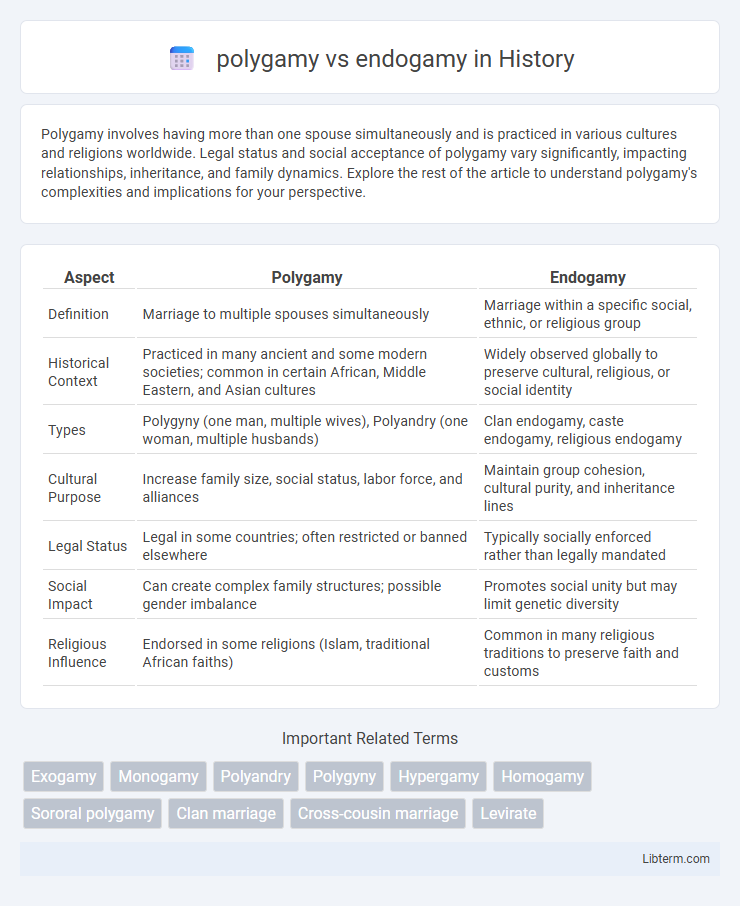Polygamy involves having more than one spouse simultaneously and is practiced in various cultures and religions worldwide. Legal status and social acceptance of polygamy vary significantly, impacting relationships, inheritance, and family dynamics. Explore the rest of the article to understand polygamy's complexities and implications for your perspective.
Table of Comparison
| Aspect | Polygamy | Endogamy |
|---|---|---|
| Definition | Marriage to multiple spouses simultaneously | Marriage within a specific social, ethnic, or religious group |
| Historical Context | Practiced in many ancient and some modern societies; common in certain African, Middle Eastern, and Asian cultures | Widely observed globally to preserve cultural, religious, or social identity |
| Types | Polygyny (one man, multiple wives), Polyandry (one woman, multiple husbands) | Clan endogamy, caste endogamy, religious endogamy |
| Cultural Purpose | Increase family size, social status, labor force, and alliances | Maintain group cohesion, cultural purity, and inheritance lines |
| Legal Status | Legal in some countries; often restricted or banned elsewhere | Typically socially enforced rather than legally mandated |
| Social Impact | Can create complex family structures; possible gender imbalance | Promotes social unity but may limit genetic diversity |
| Religious Influence | Endorsed in some religions (Islam, traditional African faiths) | Common in many religious traditions to preserve faith and customs |
Defining Polygamy and Endogamy
Polygamy is a marital practice where an individual has multiple spouses simultaneously, commonly divided into polygyny (one man, multiple wives) and polyandry (one woman, multiple husbands). Endogamy refers to the custom of marrying within a specific social, ethnic, or cultural group to preserve group identity and maintain social cohesion. While polygamy addresses the number of spouses, endogamy emphasizes the boundaries of acceptable marital partners based on group membership.
Historical Origins of Polygamy and Endogamy
Polygamy originated in ancient societies primarily as a strategy for wealth accumulation, political alliances, and ensuring offspring survival, often linked to patriarchal structures in regions like Africa, the Middle East, and Asia. Endogamy, evolving concurrently, enforced marriage within specific social, ethnic, or caste groups to preserve cultural identity and consolidate economic resources, prominent in communities across South Asia, the Middle East, and Indigenous tribes globally. Both practices have deeply influenced societal organization and kinship systems, reflecting the intersection of social hierarchy, religion, and economic imperatives in human history.
Cultural Contexts and Geographic Prevalence
Polygamy, predominantly practiced in parts of Africa, the Middle East, and some Asian regions, often reflects cultural values emphasizing family expansion, social status, and economic alliances. Endogamy, common among ethnic groups in South Asia, the Middle East, and North Africa, reinforces cultural identity and social cohesion by promoting marriage within specific social, religious, or ethnic boundaries. Both practices serve to preserve community structure but vary significantly according to historical traditions and geographic location.
Religious Influences on Marital Practices
Religious influences profoundly shape marital practices, with polygamy often endorsed in certain Islamic and traditional African religions, allowing one individual multiple spouses to reinforce social or spiritual bonds. Endogamy, prevalent in Hinduism and Judaism, mandates marriage within a specific community or caste to preserve religious identity and cultural continuity. These religious doctrines dictate the acceptability and regulation of marital customs, directly impacting societal structure and familial relationships.
Social Structures Shaped by Polygamy and Endogamy
Polygamy, often found in patriarchal societies, shapes social structures by concentrating wealth and power within extended family networks, reinforcing hierarchical relationships and lineage-based status. Endogamy promotes social cohesion by encouraging marriage within specific social, ethnic, or religious groups, maintaining cultural identity and continuity. Both practices influence kinship networks and group loyalty, impacting social stratification and community stability.
Legal Status Across Different Societies
Polygamy is legally recognized and regulated in various countries, predominantly in parts of Africa, the Middle East, and South Asia, where it is often permitted under religious or customary law. Endogamy, the practice of marrying within a specific social, ethnic, or religious group, typically lacks direct legal regulations but may be socially enforced through cultural norms and community pressures. Legal frameworks around polygamy contrast sharply with those governing endogamy, as polygamy involves formal marital arrangements, whereas endogamy generally pertains to social practices rather than legal mandates.
Gender Roles and Family Dynamics
Polygamy, prevalent in some traditional societies, often reinforces patriarchal gender roles by assigning wives distinct hierarchical positions within the family unit, shaping power dynamics and resource allocation. Endogamy, the practice of marrying within a specific social group or community, strengthens cultural continuity and social cohesion, influencing family roles by promoting collective identity and shared responsibilities. Both practices deeply affect family dynamics, with polygamy creating complex kinship ties and endogamy fostering intra-group solidarity and negotiated gender expectations.
Economic Implications of Marital Systems
Polygamy often results in complex wealth distribution and resource allocation within families, potentially concentrating economic power but also leading to increased financial strain per household. Endogamy tends to preserve economic stability by promoting asset retention and social capital within specific groups or communities, strengthening local economies through inherited wealth and business consolidation. Both systems influence economic mobility and social cohesion, shaping patterns of wealth accumulation and class structure across societies.
Social Challenges and Controversies
Polygamy often faces social challenges due to legal restrictions, gender inequality concerns, and potential family conflicts in many regions. Endogamy raises controversies related to social exclusion, reinforcement of caste or ethnic divisions, and limiting genetic diversity. Both practices impact social cohesion and provoke debates on individual rights versus cultural traditions.
The Future of Polygamy and Endogamy in Modern Societies
The future of polygamy and endogamy in modern societies hinges on evolving social norms, legal frameworks, and cultural acceptance, with increasing debates surrounding individual rights and gender equality. Technological advancements and global interconnectedness are reshaping traditional marriage practices, promoting more diverse family structures while challenging rigid endogamous customs. Policy reforms and shifting demographics continue to influence the prevalence and perception of polygamy and endogamy, signaling a gradual transformation towards more inclusive and flexible relationship models.
polygamy Infographic

 libterm.com
libterm.com